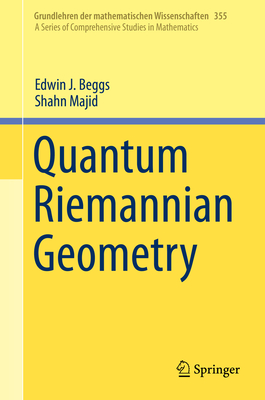You are here
Back to topQuantum Riemannian Geometry (Grundlehren Der Mathematischen Wissenschaften #355) (Hardcover)
Description
This book provides a comprehensive account of a modern generalisation of differential geometry in which coordinates need not commute. This requires a reinvention of differential geometry that refers only to the coordinate algebra, now possibly noncommutative, rather than to actual points.
Such a theory is needed for the geometry of Hopf algebras or quantum groups, which provide key examples, as well as in physics to model quantum gravity effects in the form of quantum spacetime. The mathematical formalism can be applied to any algebra and includes graph geometry and a Lie theory of finite groups. Even the algebra of 2 x 2 matrices turns out to admit a rich moduli of quantum Riemannian geometries. The approach taken is a bottom up' one in which the different layers of geometry are built up in succession, starting from differential forms and proceeding up to the notion of a quantum Levi-Civita' bimodule connection, geometric Laplacians and, in some cases, Dirac operators. Thebook also covers elements of Connes' approach to the subject coming from cyclic cohomology and spectral triples. Other topics include various other cohomology theories, holomorphic structures and noncommutative D-modules.
A unique feature of the book is its constructive approach and its wealth of examples drawn from a large body of literature in mathematical physics, now put on a firm algebraic footing. Including exercises with solutions, it can be used as a textbook for advanced courses as well as a reference for researchers.
About the Author
Edwin J. Beggs studied mathematics at Churchill college Cambridge, moving to St Catherine's college Oxford to study for a DPhil under the supervision of Graeme Segal, finishing in 1988. He became a research assistant working with David Evans on operator algebras (giving a formula for the real rank of matrix valued functions) in Swansea and was appointed to a lectureship there. He has worked with Peter Johnson, finding the inverse scattering method for solitons in affine Toda field theory. He has worked with various coauthors on noncommutative differential geometry, introducing noncommutative sheaf theory, noncommutative complex structures and bar categories as well as working on bimodule connections and quantum Riemannian geometry. He also works on physics and computation in computer science. Shahn Majid graduated from Cambridge, including Part III of the mathematics tripos, followed by a PhD at Harvard in 1988. After a year in Swansea, he spent ten years in DAMTP in Cambridge before moving to Queen Mary. He was one of the pioneers of the modern theory of Hopf algebras or quantum groups, introducing in his PhD thesis one of the two main classes at the time, the bicrossproduct ones associated to Lie group factorisations. Other results include the earliest models of quantum spacetime with quantum symmetry, the theory of Hopf algebras in braided categories and the dual/centre of a monoidal category. He was one of the coauthors of the theory of quantum principal bundles and introduced a frame bundle approach to quantum Riemannian geometry. In recent years he has been working on the bimodule approach with a view to quantum gravity.
